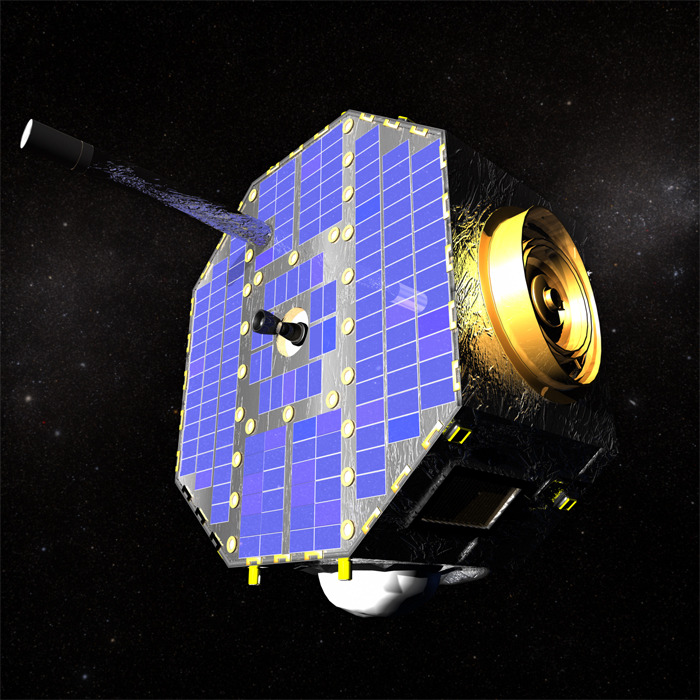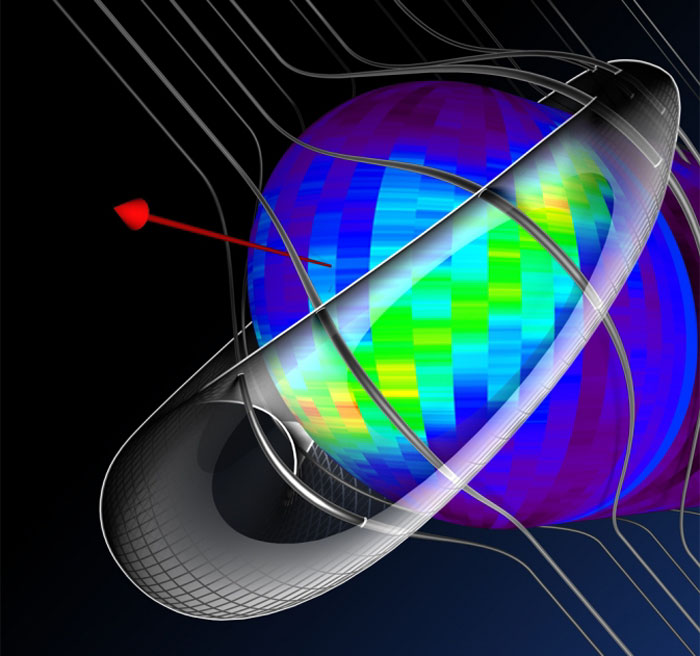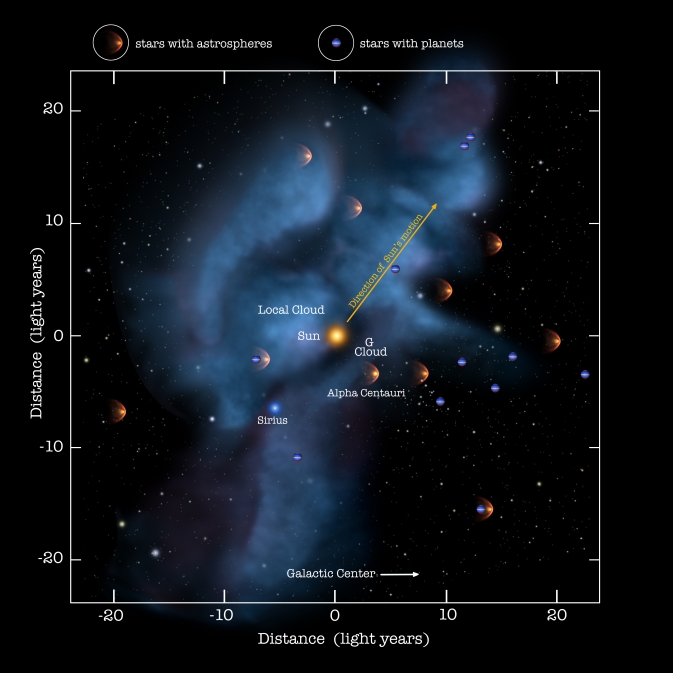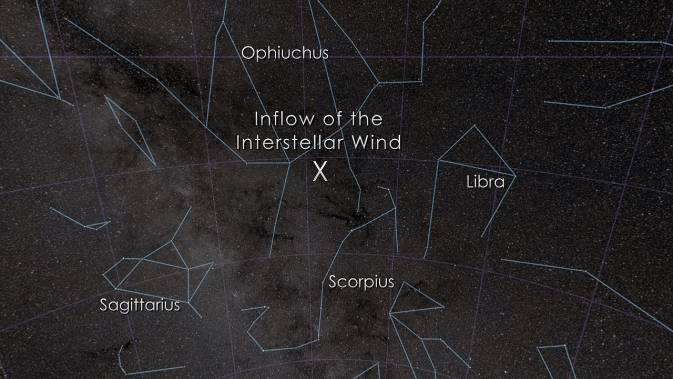.

IBEX-Launch 2008
.
NASA's IBEX Helps Paint Picture of the Magnetic System Beyond the Solar Wind
.

A model of the interstellar magnetic fields – which would otherwise be straight -- warping around the outside of our heliosphere, based on data from NASA's Interstellar Boundary Explorer. The red arrow shows the direction in which the solar system moves through the galaxy.
.
Understanding the region of interstellar space through which the solar system travels is no easy task. Interstellar space begins beyond the heliosphere, the bubble of charged particles surrounding the sun that reaches far beyond the outer planets. Voyager 1 has crossed into this space, but it’s difficult to gain a complete global picture from measurements in only one direction.
Spacecraft data in the past five years from near Earth and cosmic ray observations have painted a better picture of the magnetic system that surrounds us, while at the same time raising new questions. Scientists are challenging our current understanding in a new study that combines observations of massively energetic cosmic ray particles streaming in from elsewhere in the Milky Way along with observations from NASA's Interstellar Boundary Explorer, or IBEX.
The data sets show a magnetic field that is nearly perpendicular to the motion of our solar system through the galaxy. In addition to shedding light on our cosmic neighborhood, the results offer an explanation for a decades-old mystery on why we measure more incoming high-energy cosmic rays on one side of the sun than on the other. The research appears in the Feb. 13, 2014, issue of Science Express.
"It's a fascinating time," said Nathan Schwadron, of the University of New Hampshire in Durham and first author on the paper. "Fifty years ago, we were making the first measurements of the solar wind and understanding the nature of what was just beyond near-Earth space. Now, a whole new realm of science is opening up as we try to understand the physics all the way outside the heliosphere."
The heliosphere is formed as the constant stream of particles from the sun's solar wind flows outward in all directions until it slows down to balance the pressure from the interstellar wind. The only information gathered directly from the heart of this complex boundary region is from NASA's Voyager mission. Voyager 1 entered the boundary region in 2004, passing beyond the termination shock where the solar wind abruptly slows down. Voyager 1 crossed into interstellar space in 2012.
IBEX, which orbits Earth, studies these regions from afar. The spacecraft detects energetic neutral atoms that form from interactions at the heliosphere's boundaries – an area that holds fascinating clues to what lies beyond. These interactions are dominated by electromagnetic forces. The incoming particles from the galaxy are made up of negatively-charged electrons, positively-charged atoms called ions, neutral particles and dust. Charged particles are forced to travel along the magnetic field lines that snake throughout space. Sometimes, a charged particle collides with a neutral atom at the outskirts of the heliosphere and captures an electron from the neutral atom. After stealing the electron, the charged particle becomes electrically neutral and speeds off in a straight line. Some of these fast neutral particles stream into the inner solar system and reach IBEX's detectors. Depending on the speed and direction of those neutral particles, scientists can determine information about the atoms and magnetic field lines involved in the original collision.
In 2009, IBEX scientists presented research showing an uneven distribution of neutral atoms. There was a ribbon along the heliospheric boundaries sending a preponderance of neutral atoms toward IBEX.
Researchers wondered if this shape might also relate to an unevenness seen in cosmic rays. On Earth, we measure more cosmic rays – particles that stream in from the rest of the galaxy at 99% the speed of light – coming in from near the tail side of the heliosphere than from the other side. Teasing out the source and paths of incoming cosmic rays isn't easy as the rays gyrate around magnetic field lines both inside and outside our heliosphere before colliding with other particles in Earth’s atmosphere, giving a shower of secondary particles that, in turn, are what we detect. To complicate things further, the heliosphere is moving through the galaxy.
"At some level, it's like trying to determine the wind direction when you're riding a bike very quickly and the wind isn't particularly strong," said Eric Christian, the IBEX project scientist at NASA's Goddard Space Flight Center in Greenbelt, Md., and a co-author on the paper. "There's some effect from the wind, but it's small and hard to measure."
.

The magnetic fields in interstellar space proposed by IBEX predict that cosmic rays would come in as shown on the right – blue represents fewer rays. This looks similar to what is actually observed, shown on the left, thus supporting IBEX's findings.
.
To see if the IBEX data related to the cosmic ray observations, Schwadron used IBEX data to build a computer model of what the interplanetary magnetic field would look like around the heliosphere. Without the heliosphere, the field lines would be straight and parallel.
"But the heliosphere is kind of like an egg sitting in the middle of all these magnetic field lines," said Schwadron. "The field lines have to distort themselves around that."
With this model in hand, he simulated how the heliosphere would affect the cosmic rays. He assumed that the rays came in to the heliosphere evenly from everywhere in space, but allowed them to be warped based on the local magnetic geometry. The simulations showed a non-uniform distribution of cosmic ray particles that jibed well with the unevenness seen in observations.
“The analysis of this important paper strongly correlates with the theoretical view of the heliosphere from the numerical model developed by our team, which uses IBEX observations to derive the interstellar magnetic field direction,” said Nick Pogorelov, a space scientist at the University of Alabama in Huntsville, who works with IBEX data. “It shows that the heliopause that separates solar and interstellar plasmas is very long, maybe 2 trillion miles in the downwind direction, and therefore may affect the transport of high-energy cosmic rays toward the solar system.”
Unfortunately, this doesn't prove that the heliosphere and the interstellar magnetic field are exclusively responsible for the cosmic ray mystery. However, this research shows that the magnetic configuration of our neighborhood does offer a potential answer.
Moreover, the agreement between what's seen in the cosmic ray data and by IBEX provides outside confirmation of IBEX's results of what the magnetic fields outside our heliosphere look like. That's an interesting piece of the puzzle, when compared with Voyager 1's measurements, because the Voyager 1 data provide a different direction for the magnetic fields just outside our heliosphere.
This doesn't mean that one set of data is wrong and one is right, says Schwadron. Voyager 1 is taking measurements directly, gathering data at a specific time and place; IBEX gathers information averaged over great distances, so, there is room for discrepancy. Indeed, that discrepancy can be used as a clue. Understand why there's a difference between the two measurements and we gain additional information. More IBEX observations and more Voyager observations will keep coming in. As with all research, more data will help unravel the picture and soon we will learn even more about how we fit into the rest of the universe.
.
Eleven Spacecraft Show Interstellar Wind Changed Direction Over 40 Years
.

The solar system moves through a local galactic cloud at a speed of 50,000 miles per hour, creating an interstellar wind of particles, some of which can travel all the way toward Earth to provide information about our neighborhood.
.
Like the wind adjusting course in the middle of a storm, scientists have discovered that the particles streaming into the solar system from interstellar space have most likely changed direction over the last 40 years. Such information can help us map out our place within the galaxy surrounding us, and help us understand our place in space.
The results, based on data spanning four decades from 11 different spacecraft, were published in Science on Sept. 5, 2013.
Vestiges of the interstellar wind flowing into what's called the heliosphere -- the vast bubble filled by the sun's own constant flow of particles, the solar wind – is one of the ways scientists can observe what lies just outside of our own home, in the galactic cloud through which the solar system travels. The heliosphere is situated near the inside edge of an interstellar cloud and the two move past each other at a velocity of 50,000 miles per hour. This motion creates a wind of neutral interstellar atoms blowing past Earth, of which helium is the easiest to measure.
"Because the sun is moving though this cloud, interstellar atoms penetrate into the solar system," said Priscilla Frisch, an astrophysicist at the University of Chicago, Ill. and the lead author on the paper. "The charged particles in the interstellar wind don't do a good job of reaching the inner solar system, but many of the atoms in the wind are neutral. These can penetrate close to Earth and can be measured."
Frisch became interested in this subject when results in January 2012 from NASA's Interstellar Boundary Explorer, or IBEX, showed that the interstellar wind was entering the heliosphere from a slightly different direction than had been observed by NASA's Ulysses mission in the 1990s. Frisch and her colleagues set out to gather as much evidence from as many sources as they could to determine whether the newer instruments simply provided more accurate results, or whether the wind direction itself changed over the years.
The earliest historical data on the interstellar wind comes from the 1970s from the U.S. Department of Defense's Space Test Program 72-1 and SOLRAD 11B, NASA's Mariner, and the Soviet Prognoz 6. While instruments have improved since the 1970s, comparing information from several sets of observations helped the researchers gain confidence in results from that early data. The team went on to look at another seven data sets including the Ulysses information from 1990 to 2001, and more recent data from IBEX, as well as four other NASA missions: the Solar Terrestrial Relations Observatory, or STEREO, the Advanced Composition Explorer, or ACE, the Extreme Ultraviolet Explorer, and the MErcury Surface, Space ENvironment, GEochemistry, and Ranging mission, or MESSENGER, currently in orbit around Mercury. The eleventh set of observations came from the Japanese Aerospace Exploration Agency's Nuzomi.
"The direction of the wind obtained from the most recent data does not agree with the direction obtained from the earlier measurements, suggesting that the wind itself has changed over time," said Eric Christian, the IBEX mission scientist at NASA’s Goddard Space Flight Center in Greenbelt, Md. "It's an intriguing result, which relied on looking at a suite of data measured in a bunch of different ways."
The various sets of observations relied on three different methods to measure the incoming interstellar wind. IBEX and Ulysses directly measure neutral helium atoms as they coursed through the inner solar system. IBEX's measurements are made close to Earth, while Ulysses' measurements reach out to the orbit of Jupiter.
The earliest measurements in the 1970s observed fluorescence that occurs when the extreme ultraviolet radiation coming from the sun scatters off the interstellar helium wind passing by the sun. Neutral helium atoms get caught by the sun's gravity, forming a focusing cone. As radiation from the sun bounces off these atoms, they give off light. Measuring the light provides information about the helium inflow direction.
The third technique to measure the helium wind relies on the fact that after this interaction with the sun's radiation, a fraction of neutral helium atoms gain an electron, and thus become charged. Many instruments in space are geared to study charged particles, such as instruments on NASA’s STEREO and ACE. Such instruments can measure the longitudinal direction of the particle wind, providing one last set of historical observations to round out the picture.
.

From Earth's perspective, the interstellar wind flows in from a point just above the constellation Scorpius. Results from 11 spacecraft over 40 years show that the exact direction has changed some 4 to 9 degrees since the 1970s.
.
The data from these diverse sources shows that the direction of the interstellar wind has changed some 4 to 9 degrees over the last 40 years.
"Previously we thought the local interstellar medium was very constant, but these results show that it is highly dynamic, as is the heliosphere’s interaction with it," said David McComas, IBEX principal investigator at Southwest Research Institute in San Antonio, Texas.
While the reason for – and, indeed, the exact timing of – the shift is still unclear, Frisch pointed out that scientists know our solar system is close to the edge of the local interstellar cloud. Such an area of the galaxy might experience turbulence, and as we hurtle through space, the heliosphere could be exposed to different directions of wind. While the scientists don't yet know for sure how the direction switch happened, the team believes that additional observations should ultimately explain its cause, giving us even more information about the galaxy that surrounds us.
Quelle: NASA
6203 Views
